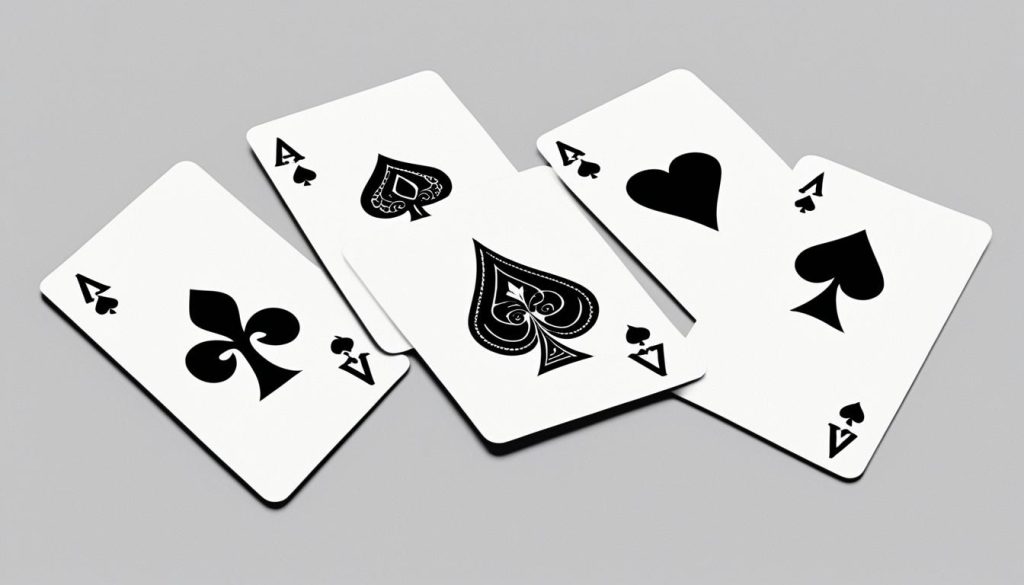Welcome to our guide on how to play Spades card game, one of the most popular games around the world. Whether you’re a beginner or a seasoned player, understanding the rules of Spades is crucial to enjoying this thrilling and strategic game.
In Spades, each player or team aims to bid and win a specific number of tricks to emerge victorious. This exciting game is played with a standard 52-card deck, and the spade suit always holds the power as the trump suit.
Throughout this article, we’ll walk you through the fundamental rules and strategies to help you become a skilled Spades player. So let’s dive in and discover the secrets of this captivating card game!
The Pack and Rank of Suits
In spades, the game is played with a standard 52-card deck. Each card represents one of four suits: spades (♠), hearts (♥), diamonds (♦), and clubs (♣). Understanding the rank of suits is crucial to playing spades effectively. The spade suit holds the highest rank and is always designated as the trump suit in the game, followed by hearts, diamonds, and clubs.
Within each suit, the cards are further ranked from highest to lowest. The rank of cards in spades, from highest to lowest, is as follows:
- Ace (🂡)
- King (🂠)
- Queen (🂩)
- Jack (🂪)
- 10
- 9
- 8
- 7
- 6
- 5
- 4
- 3
- 2
It’s important to remember that while spades holds the highest rank, every suit has its own hierarchy within the game. Understanding the rank and suit structure will help you make strategic decisions and outmaneuver your opponents in spades.

How to Play Spades Card Game?
Spades is a classic trick-taking card game that is usually played with four players in partnerships. Here’s a guide on how to play Spades:
What is the Objective of the Spades?
The goal of the game is for your partnership to score 500 points first. To achieve this, you need to accurately predict the number of tricks you and your partner can win in each round.
How to Setup Spades?
- A standard deck of 52 cards is used, and spades are always the trump suit.
- Players are divided into two partnerships, with partners sitting across from each other.
Scoring
- Each trick won earns 10 points.
- If a partnership’s total tricks match their bid, they earn an additional 10 points per trick bid.
- If a partnership exceeds their bid, they lose 10 points for each overtrick.
How to Win in Spades?
- The first partnership to reach 500 points wins the game.
- If both partnerships reach 500 points in the same round, the one with the higher score wins.
Additional Rules
“Nil Bid”: A player can bid nil, meaning they predict not to win any tricks. Successfully accomplishing this earns additional points.
“Blind Nil”: A more challenging bid where the player declares nil without looking at their cards first.
Spades is a strategic game that requires communication and teamwork with your partner. Develop a good understanding of your partner’s playing style and hand signals to enhance your chances of winning. If you have any questions or need further clarification on the rules, feel free to ask! Enjoy playing Spades!
Tips for Winning Tricks in Spades:
- Pay attention to the cards played by your opponents to determine which suit is likely to win the current trick.
- Remember the rank of cards and prioritize playing higher-ranking cards to increase your chances of winning tricks.
- Strategically use spades to beat other suits and potentially win valuable tricks.
- Coordinate with your partner to maximize your tricks and outplay the opposing team.
By focusing on winning tricks and accurately bidding on the number of tricks you can win, you can improve your chances of success in the game of Spades. Remember, practice makes perfect, so keep honing your skills and enjoy the strategic gameplay that Spades offers.
The Bidding and The Play
In the game of spades, the bidding phase plays a crucial role in determining each player’s or team’s strategy. During this phase, players or teams make predictions on the number of tricks they believe they can win. Bidding commences with the player to the left of the dealer and continues in a clockwise direction.
It is important to note that there is only one round of bidding, and the minimum bid allowed is one. Each bid represents the player’s or team’s estimation of their potential to win tricks during the game.
Once the bidding is complete, the actual gameplay begins. The player sitting to the left of the dealer leads the first trick by playing a card from their hand. This card determines the suit that other players must follow, if possible. If a player is unable to follow suit, they can play a trump card from the spade suit or discard a card from another suit.
The key to winning tricks in spades is playing strategically. Players aim to win the trick by playing the highest card of the suit led or by playing the highest trump card if a trump is played. If no trump cards are played, the highest card in the suit led wins the trick.
It is important for players to consider their bids, the cards they hold, and the cards played by other players to make informed decisions during the gameplay. Strategy, timing, and careful observation play pivotal roles in the outcome of each trick and, ultimately, the game.

Tips for Playing Tricks in Spades:
- Think strategically and plan your moves based on the bids made by other players.
- Observe the cards played by opponents and keep track of which cards are still in play.
- When leading a trick, consider playing a high-ranking card to increase your chances of winning the trick.
- Use trump cards strategically to gain an advantage over other players.
- Discard low-ranking cards when unable to follow suit or play a trump.
How to Keep Score?
In the game of spades, scoring is based on the number of tricks won and the fulfillment of bids. A well-executed scoring system ensures fairness and adds an extra layer of strategy to the game.
Here’s how the scoring works:
- Contract Points: Each player or team scores 10 points for each trick they bid to win. This rewards accurate predictions and encourages players to assess their capabilities wisely.
- Overtricks Points: In addition to the contract points, players or teams also earn 1 point for each overtrick, which is when they win more tricks than they initially bid. This incentive encourages players to take calculated risks and reap additional rewards.
- Failed Contract: If a player or team fails to meet their bid and falls short of the contracted number of tricks, they receive 0 points. This penalty emphasizes the importance of accurate bidding and adds tension to the game.
- Bags: Accumulating bags refers to winning overtricks beyond the initial contract. Each bag incurs a penalty. Generally, players or teams are penalized for every 10 bags acquired, which leads to deduction of points. This rule discourages excessive overtricks and adds an element of strategy to the game.
The scoring system in spades incentivizes players to balance risk and reward, aiming to fulfill their bids without accumulating unnecessary overtricks or bags. It rewards skillful gameplay, accurate bidding, and strategic decision-making.
Here’s a visual representation of the scoring system:
| Scoring Element | Points |
|---|---|
| Contract Points | 10 points per trick bid |
| Overtricks Points | 1 point per overtrick |
| Failed Contract | 0 points |
| Bags Penalty | Points deduction for accumulating bags |

Understanding the scoring system in spades is essential for players who want to excel at the game. It adds an extra layer of excitement and strategy, making each hand more engaging and rewarding.
Conclusion
Spades is a strategic card game that requires players to employ various tactics and implement effective strategies in order to maximize their chances of winning. By familiarizing themselves with the rules and honing their skills, players can become formidable opponents in this thrilling game.
So, whether you are playing with friends in person or challenging opponents online, remember to apply these spades strategies, spades tips, and spades tactics to enhance your gameplay. With practice, patience, and a bit of luck, you can become a skilled spades player and enjoy the thrill of this captivating card game.
FAQ
How to Play Spades With 2 People?
Playing spades with 2 players can be just as enjoyable and competitive as playing with a larger group. To start, you’ll need a standard 52-card deck and an understanding of the basic rules of spades. Each player is dealt 13 cards, and the goal is to take at least the number of tricks that were bid at the beginning of each round. The trump suit is determined by a bidding process before each hand. It’s important to communicate with your partner and strategize together to outsmart your opponents.
How to Play Spades With 3 People?
Playing Spades with three people may seem challenging, but with our helpful tips and tricks, you’ll be a pro in no time. Firstly, determine the order of play by shuffling and dealing out all 52 cards. The player to the left of the dealer leads the first trick by playing any card from their hand. Then, each player must follow suit if possible or play a spade if they don’t have that suit. The highest-ranking card played wins the trick and leads the next one. Keep track of points based on bids made before gameplay begins.
Do You Take Out 2 of Hearts in Spades?
In the traditional game of Spades, the 2 of hearts is not removed from the deck. It remains in play and can be used just like any other card in the game. However, some variations of Spades may have different rules regarding the 2 of hearts, so it’s always best to clarify with your fellow players before starting a game.






